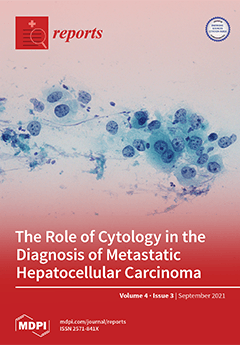Open AccessArticle
Usefulness of Circulating CYFRA21-1 in Patients as a Biomarker in Patients Taking Sorafenib or Lenvatinib for Unresectable Hepatocellular Carcinoma
by
Hitomi Takada, Leona Osawa, Yasuyuki Komiyama, Ryoh Kato, Natsuko Nakakuki, Masaru Muraoka, Yuichiro Suzuki, Akihisa Tatsumi, Mitsuaki Sato, Ei Takahashi, Shinichi Takano, Mitsuharu Fukasawa, Tatsuya Yamaguchi, Taisuke Inoue, Shinya Maekawa and Nobuyuki Enomoto
Viewed by 3181
Abstract
Background: This study investigated the impact of serum cytokeratin 19 fragment (CYFRA21-1) level on the clinical outcomes of patients with unresectable hepatocellular carcinoma (HCC) treated with sorafenib (SOR) or lenvatinib (LEN). Methods: A total of 71 cases with unresectable HCC taking SOR or
[...] Read more.
Background: This study investigated the impact of serum cytokeratin 19 fragment (CYFRA21-1) level on the clinical outcomes of patients with unresectable hepatocellular carcinoma (HCC) treated with sorafenib (SOR) or lenvatinib (LEN). Methods: A total of 71 cases with unresectable HCC taking SOR or LEN were included. Univariate and multivariate analyses were performed to identify the prognostic factors in patients taking SOR or LEN. Results: Among the 71 patients taking SOR or LEN, the frequency of cases showing high CYFRA21-1 levels after administration increased compared to before the administration. There was no association between the CYFRA21-1 level and the result of treatment response using modified Response Evaluation Criteria in Solid Tumors (mRECIST) 12 weeks after the administration. Univariate analysis identified a maximum intrahepatic tumor diameter of 70 mm or more, extrahepatic metastasis, baseline alpha-fetoprotein (AFP) ≥ 2000 ng/mL, baseline AFP-L3 index ≥ 15%, baseline des-gamma-carboxy prothrombin (DCP) ≥ 1000 mAU/mL, baseline CYFRA21-1 > 3.5 ng/mL, 12-week mRECIST progressive disease (PD), 12-week DCP ratio ≥ 4, 12-week CYFRA21-1 ratio ≥ 2, administration period less than 12 weeks, ALBI grade 3 at PD, and no additional treatment after discontinuation of SOR/LEN as prognostic factors. Multivariate analysis revealed that AFP-L3 index ≥ 15%, 12-week mRECIST PD, 12-week DCP ratio ≥ 4, 12-week CYFRA21-1 ratio ≥ 2, administration period less than 12 weeks, and no additional treatment after discontinuation of SOR/LEN were independent factors. Conclusions: Patients with a high CYFRA21-1 level at baseline tend to have poor prognosis, and patients with a high CYFRA21-1 ratio 12 weeks after administration have poor prognosis. Serum CYFRA21-1 measurement may have additional effects on prognostic prediction, and it may be necessary to pay close attention to the transition to the next HCC treatment in cases whose CYFRA21-1 level is high.
Full article
►▼
Show Figures





